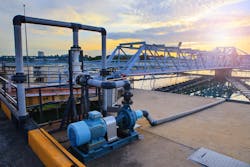As we race toward 2023, saddled with lingering global uncertainty, the outlook for investment and participation in the water sector is bolstered by strengthening tailwinds. This is the benefit of an industry supplying the one thing humans cannot live without: water.
No region, industry, or household is immune to the potential impacts of water stress, from drought and flooding to poor water quality. Look no further than to the Western United States and Europe, where ongoing droughts have resulted in reservoir levels that are well below average — or to Jackson, Miss., where 150,000 residents were left without clean water this year. At the same time, blackouts in South Africa are undermining water utilities’ ability to reliably deliver services.
Certainly, the challenges to overcome these shortcomings are immense, but they are also the result of past achievements for which the industry should be applauded. Incredible achievements, at that: delivering safe drinking water and sewer services to billions of people, globally. Taking the glass half full perspective — widespread, reliable infrastructure services are possible.
Unfortunately for industry stakeholders (in this case, the entire population), water sector resiliency is not an end unto itself. Rather, it is one milestone among many that lie before us to address emerging challenges — foreseen and unforeseen.
Will the U.S. Federal Reserve deliver a soft landing for water’s supply chain?
After hitting permit levels not seen since 2006, housing starts in the U.S. have begun falling back to earth and, as a result, exposed the municipal water sector’s supply chain. Behind this trend are the rising federal funds rates (i.e., interest rates, mortgage rates). Nearly two-thirds of capital expenditures for distribution and collection pipe network is associated with new infrastructure buildout accompanying new residential housing construction. A significant slowdown, which is already impacting commercial properties (e.g., offices), could threaten the near-to-medium-term opportunities for hardware and equipment providers and engineering firms.
Will U.S. companies take advantage of a strong dollar to expand their presence in water?
A strong dollar is set to benefit well capitalized, acquisitive U.S. firms seeking to buy closer to the bottom. The pound has been slipping since 2016 (i.e., Brexit) and the Euro is following suit. Given that the exchange rate trend is not expected to rebound significantly amid all the geopolitical and economic uncertainty, U.S. firms are poised to benefit. Still, they must withstand market volatility, such as inflation, workforce pressures, energy prices, and the coming AMP8 (2025–2030) regulatory cycle in the U.K.
How fast will water management adapt to changing energy, power sector demands?
This robust growth in renewable capacity — displacing decommissioned, water-intensive coal and gas generation capacity — will drive significant changes in water management, from volumetric demand to treatment solutions. Realistically, this downward trend is likely to be offset in the long-term by other incentivized subsegments, including oil and gas on federal lands, new nuclear solutions, and green hydrogen. As such, new challenges and opportunities are expected to emerge.
The Clean Water Act has been called into question, 50 years later. What are the implications?
The EPA and the U.S. Army Corps of Engineers’ staff has reported that at least 18 percent of streams and 51 percent of wetlands nationwide would not be protected under a revised definition of WOTUS, thereby potentially reshaping the permit and compliance landscape for companies going forward.
How will utilities respond to the rapid shift in service demand patterns?
The COVID-19 pandemic, coupled with more flexible work-from-home policies, are undermining historical utility service demand patterns. While gross water and wastewater expenditures remain on pace with historical trends, the net impacts — utility revenues and tax base declines — will increasingly be felt at local levels, thereby placing extreme pressure on large urban utilities.
A key barometer of this trend are the tens of millions of square feet of empty office space in New York, Boston, Philadelphia, and San Francisco, where commercial vacancy rates have not fully returned to pre-pandemic levels. Over the past 12 months, vacancy rates rose in 86 of 120 metropolitan markets, according to CommercialEdge, which signals continued softness in commercial demand. Given that water and wastewater rates can only rise so fast, utilities will increasingly be compelled to be more creative and innovative in how they adapt to this paradigm shift.
Will the E.U. take stronger regulatory actions to address PFAS?
The growing geographic reach of PFAS regulations — including potential liabilities for past releases of contaminants — is expected to place additional stress on associated companies (e.g., chemical and firefighting foam manufacturers). This will, in turn, spark water-related remediation efforts going forward. While significant emphasis has been placed on the U.S. market, which is forecasted to reach US$3.1 billion in annual treatment by 2030, more wide-sweeping European Union policy enforcement actions could ultimately push Europe past the U.S. as a leading market for water treatment solutions providers. The E.U.’s more top-down environmental focus means that PFAS regulatory actions could accelerate more quickly in E.U. member states.
The E.U.’s Drinking Water Directive, implemented on Jan. 12, 2021, heightens the focus by establishing guidelines for PFAS monitoring and testing across member states three years from the directive’s implementation date. Requirements for monitoring and compliance are expected to be implemented within five years, thereby necessitating investment in more advanced treatment technologies and solutions.
What are the long-term impacts of U.S. federal infrastructure investment?
The Infrastructure Investment and Jobs Act (IIJA) presents an historic opportunity for U.S. utilities. The IIJA explicitly allocates US$55 billion of new funding for water and wastewater infrastructure between 2022 and 2026. Bluefield Research has gone so far as to identify a combined total of US$132 billion in IIJA funding potentially relevant to the water sector.
While the funding is slated to be funneled mostly through traditional channels (i.e., state revolving funds), questions remain about the speed, scale, and feasibility of project roll outs. A host of overarching issues remain to be defined, including the Build America, Buy America domestic sourcing provisions and state-level definitions of “disadvantaged communities.”
Reservoirs are running dry. What’s next?
More than 36 million people, farmers, and power supplies, in addition to the country of Mexico, are exposed to declining water levels of the Colorado River. On June 14, 2022, the U.S. Bureau of Reclamation, a federal agency, issued an emergency request for the seven states in the Colorado River Basin to identify 2 to 4 million acre-feet of water use reductions over the next 18 months. In the absence of a state-driven solution, the U.S. Bureau of Land Management is currently prepared to exert its authority and mandate cuts.
But this situation is not unique. Droughts, whether they be in Europe, the Western U.S., or Asia, are increasing our exposure to critical infrastructure failures, including the power sector’s exposure to water stress. In the summer of 2022, four of 16 European countries reported water reservoir levels below 75 percent (of a 2015-2021 average) and Portugal’s storage capacities were below 50 percent of average for 31 weeks. As these once reliable sources of water (and power) become exposed to climate change, water utilities, companies, and residential property owners will be forced to be more efficient in their water usage — mandated or not.
While we cannot predict exactly how 2023 will play out, we know that the opportunities in water will grow to drive conservation strategies and financial efficiencies. Among the bright spots are the growing, proactive approaches to corporate water management.
Certainly, greenwashing and brand marketing efforts are influencing decisions but, as a whole, companies are increasingly seeing water stress as a risk — with very real consequences for their bottom line — and are taking a more positive steps, instead of just waiting on regulations. For better or worse, the spotlight will be on water in 2023. WW
About the Author
Reese Tisdale
Reese Tisdale is president and CEO of Bluefield Research. He has an extensive background in industry research, strategic advisory, and environmental consulting in the power and energy industries. His interest in critical infrastructure needs and developing markets is influenced by his three years in El Salvador, where he led water supply and agriculture projects immediately following the country’s civil war. He has a B.S. in natural resources from The University of the South, Sewanee, and an MBA from Thunderbird: The American Graduate School of International Management.



